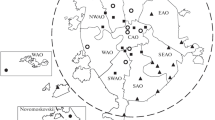Abstract
Changes in the anthropogenic impact from two large Russian industrial regions (Norilsk and the Urals) on the environment of Siberia due to the transformation of the atmospheric circulation in the early 2000s are assessed. Five-day trajectories of air mass transport for every day of January, April, July, and October in 1981–2007 calculated by the HYSPLIT-4 model with the NOAA reanalysis database (NCEP/NCAR Reanalysis Data Files) are used to analyze the transport of anthropogenic aerosols. Rosgidromet (Russian Hydrology and Meteorology Center) information on atmospheric emissions from the regions under study is used. Seasonal and long-term variations in the average concentrations of anthropogenic heavy metals (Pb, Ni, and Cu) from those sources in near-surface air and the average flows of pollutants onto the surface were estimated for different Siberian sites. Differences between the 2000s and the 1990s are characterized by various mosaic spatial patterns in different seasons. From the viewpoint of pollution of surface environments and objects, the effect from the transformation of the atmospheric circulation may be comparable (but opposite) with that from changes in source emissions, which decreased in the studied decades. Annual depositions of heavy metals (only from the two sources) onto the catchment area of every large Siberian river (Ob, Yenisei, and Lena) are comparable with the flows of these metals in the river run-off.
Similar content being viewed by others
References
A. Rahn, Atmos. Environ. 15(8), 1447–1455 (1981).
Arctic on the Verge of the Third Millennium (Resource Potential and Ecological Problems) (Nauka, St. Petersburg, 2000) [in Russian].
AMAP, Arctic Pollution 2002, Oslo, Norway (AMAP, 2002).
A. A. Vinogradova and T. Ya. Ponomareva, Fiz. Atmos. i Okeana 37(6), 761 (2001).
A. A. Vinogradova, “Anthropogenic aerosol over Seas of the Arctic Ocean,” Doctoral Dissertation in Geographical Sciences (Moscow, 2004).
A. A. Vinogradova and T. Ya. Ponomareva, Atmos. Oceanic Opt. 20(6), 433–441 (2007).
A. A. Vinogradova, L. O. Maksimenkov, and F. A. Pogarskii, Atmos. Ocean Opt. 21(6), 415 (2008).
R. R. Draxler and G. D. Rolph, HYSPLIT (HYbrid Single-Particle Lagrangian Integrated Trajectory), Model access via NOAA ARL READY Website (http://www.arl.noaa.gov/ready/hysplit4.html).
Year-Book of the State of Air Pollution and Pollutant Emissions into the Atmosphere of Towns and Industrial Centers of the Soviet Union in 1989, Vol. Pollutant Emissions (Leningrad, 1990) [in Russian].
Year-Book of Pollutant Emissions into the Atmosphere of Town and Regions of the Russian Federation (Russia) in 1997 (St. Petersburg, 1998) [in Russian].
J. M. Pacyna, “Source Inventories for Atmospheric Trace Metals,” in Atmospheric Particles, Ed. by R. M. Harrison and R. Van Grieken (Wiley, New York, 1998), pp. 385–423.
M. V. Gal’perin, M. Sofiev, A. Gusev, and O. Afinogenova, Approaches to Simulation of Transborder Pollution of the European Atmosphere by Heavy Metals. Report 7/95 (EMEP/MSC East, Moscow, 1995) [in Russian].
F. Ya. Rovinskii, S. A. Gromov, L. V. Burtseva, and S. G. Paramonov, Meteorol. Gidrol., No. 10, 5 (1994).
N. L. Byzova, E. K. Garger, and V. N. Ivanov, Experimental Investigations of Atmospheric Diffusion and Calculations of Pollutant Dissipation (Gidrometeoizdat, Leningrad, 1991) [in Russian].
Geographic Atlas (Central Directorate on Geodesy and Cartography at the Soviet of Ministers of the USSR, Moscow, 1967) [in Russian].
L. M. Kitaev, V. F. Radionov, E. Forland, et al., Meteorol. Gidrol., No. 11, 65 (2004).
Formation and Dynamics of Modern Climate in Arctic, Ed. by G. V. Alekseev (Gidrometeoizdat, St. Petersburg, 2004) [in Russian].
A. A. Vinogradova, L. O. Maksimenkov, and F. A. Pogarskii, Izv. Atmos. Oceanic Phys. 44(6), 753 (2008).
A. A. Vinogradova, Priroda, No. 1, 86 (2008).
A. A. Sokolov, Hydrography of the USSR (Gidrometeoizdat, Leningrad, 1964) [in Russian].
V. V. Gordeev, “Rivers of Russian Arctic: Flows of Sedimentary Material from the Continent to the Ocean,” in New Ideas in Oceanology (Nauka, Moscow, 2004), Vol. 2, pp. 113–167 [in Russian].
A. M. Nikanorov and A. V. Zhulidov, Biomonitoring of Metals in Freshwater Ecosystems (Gidrometeoizdat, Leningrad, 1991) [in Russian].
Author information
Authors and Affiliations
Additional information
Original Russian Text © A.A. Vinogradova, L.O. Maksimenkov, F.A. Pogarskii, 2009, published in Optica Atmosfery i Okeana.
Rights and permissions
About this article
Cite this article
Vinogradova, A.A., Maksimenkov, L.O. & Pogarskii, F.A. Changes in the atmospheric circulation and environmental pollution in Siberia from the industrial regions of Norilsk and the Urals in the early 21st century. Atmos Ocean Opt 22, 396–404 (2009). https://doi.org/10.1134/S1024856009040034
Received:
Published:
Issue Date:
DOI: https://doi.org/10.1134/S1024856009040034




